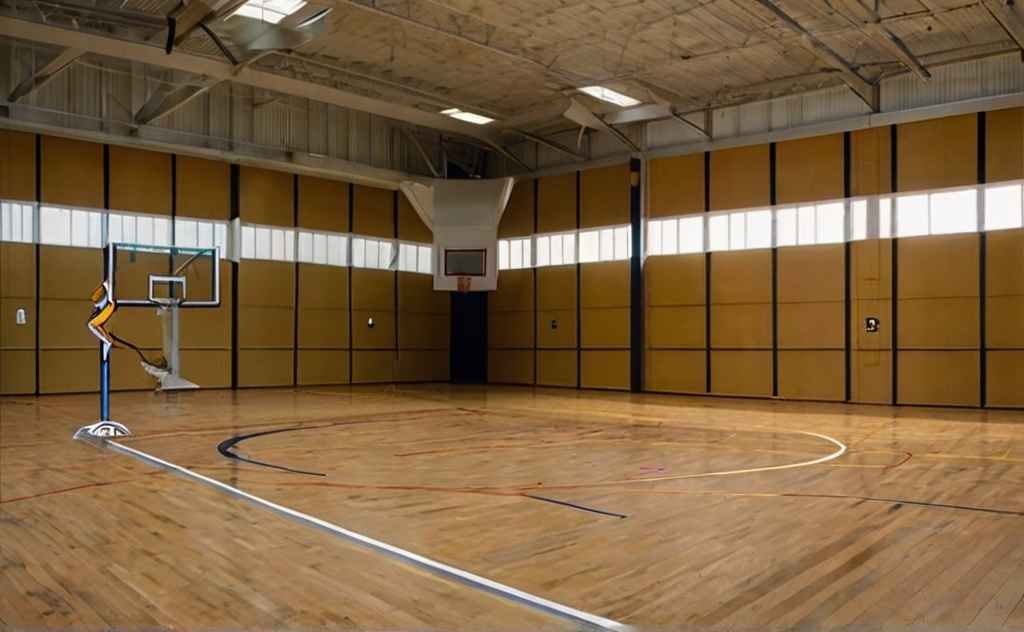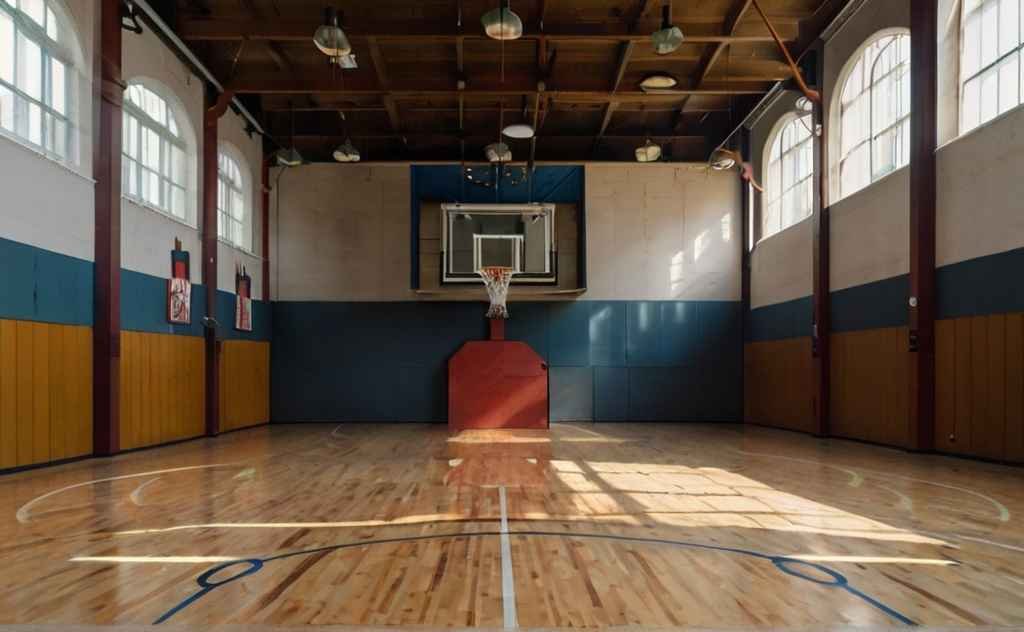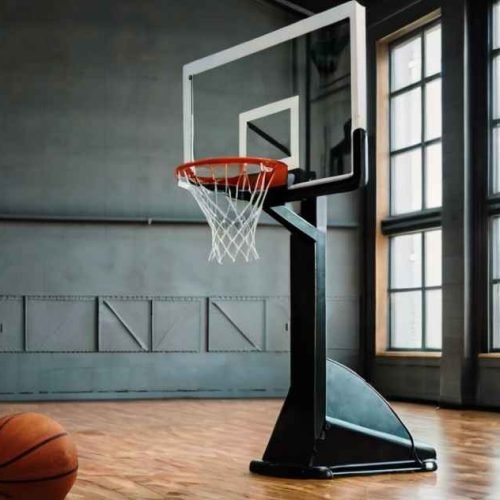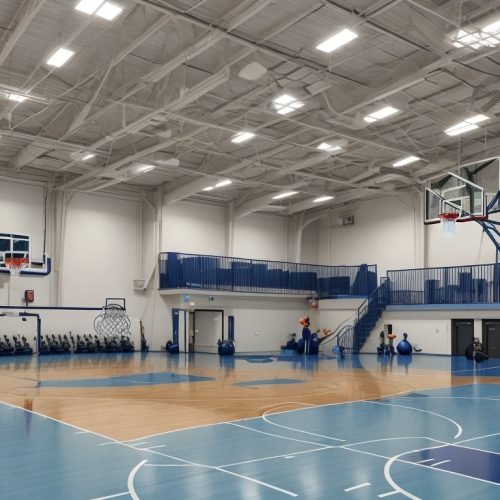Player, coach, and fan excitement surrounds indoor basketball courts, where skill shines and triumphs are won. The size of an indoor basketball court, whether professional arenas or neighbourhood gyms, reflects the global principles of fair play and consistent competitiveness.
These sacred areas allow athletes to weave among defenders, execute accurate passes, and launch precise shots. Every dribble and net stroke resonates with the crowd’s energy on the polished hardwood.Knowing these courts’ dimensions is like knowing the game’s blueprint for players, coaches, and fans. It underpins strategies, plays, and victories. From baseline to three-point arc, key to free-throw line, every inch of the court is strategic.
Indoor basketball players follow standardised dimensions as a sacred pact to keep the spirit of competition pure. Since the regulations are the same whether playing professionally or in the local gym, everyone has a fair chance.Thus, when the ball bounces and sneakers squeak across the hardwood, the indoor basketball court’s dimensions silently testify to the game’s tradition of integrity, skill, and unwavering enthusiasm.
Explore: What are indoor basketball courts made of?
Dimension
The dimensions of an indoor basketball court are painstakingly regulated by organisations such as the National Basketball Association (NBA) and the International Basketball Federation (FIBA). This ensures that all levels of play are played in a manner that is consistent and fair. The following is a rundown of the most important measurements:
Length: The length of the basketball court, spanning 94 feet (28.65 meters) in NBA-standard arenas, plays a crucial role in shaping the flow of the game. This expanse provides ample room for players to execute fast breaks, set up offensive plays, and engage in defensive maneuvers. From the lightning-fast drives to the graceful arcs of jump shots, every inch of the court is utilized as players navigate the length of the hardwood battlefield.
Width: With a standard width of 50 feet (15.24 meters), the basketball court offers a symmetrical stage for athletes to showcase their skills. This width ensures sufficient space for players to maneuver, pass, and defend, fostering dynamic gameplay and strategic interactions. Whether it’s weaving through defenders on the perimeter or battling for position in the paint, the width of the court shapes the intensity and rhythm of the game.
Explore:How high ceiling for indoor basketball court?

Key Areas:
- Free-Throw Line: Positioned 15 feet (4.57 meters) from the backboard, the free-throw line serves as a pivotal marker for players to showcase their shooting prowess. Here, athletes must exhibit concentration, technique, and nerve as they aim to capitalize on scoring opportunities from the charity stripe.
- Three-Point Line: The three-point line, a boundary that extends around the perimeter of the court, delineates the range for shots worth three points. Its distance from the basket, whether at 23.75 feet (7.24 meters) in the NBA or 22.15 feet (6.75 meters) in FIBA-regulated games, challenges players to master the art of long-range shooting, adding an electrifying dimension to the game.
- Key or Paint Area: Nestled beneath the hoop, the key, also known as the paint area, is a battleground where players vie for position, rebounds, and scoring opportunities. Its standardized dimensions, whether in the NBA or FIBA, provide a focal point for interior play, with players utilizing footwork, strength, and finesse to gain an advantage in the low post.
By understanding and adhering to these standardized dimensions, players, coaches, and fans ensure the integrity and consistency of the game, fostering a shared language and appreciation for the timeless spectacle of basketball.
Regulation size of an indoor basketball court:
Precision and consistency are the two most important qualities to possess in the world of professional basketball. In prestigious leagues such as the National Basketball Association (NBA), the official measurements of an indoor basketball court are 94 feet in length and 50 feet in breadth (28.65 metres by 15.24 metres, respectively). These dimensions serve as a monument to players’ dedication to the sport.
In order to guarantee a level playing field in which every inch counts, this measurement takes into account not only the spotless playing surface but also the crucial areas that are outside the boundaries of the game. The regulation size of the court serves as the canvas upon which the creativity of the game emerges with an unrivalled clarity. This includes everything from the thunderous slam dunks to the delicate touch of a fadeaway jumper.
Half-Court Dimensions:
The half-court line beautifully divides the court into two equal halves, each measuring 47 feet in length and 50 feet in breadth (14.33 metres and 15.24 metres, respectively). This broad expanse is characterised by the court being gracefully bisected by the half-court line. In order to provide teams with a painstakingly created field in which to hone their abilities and build their strategic prowess, this symmetrical division acts as the cornerstone of planned practice sessions and hard exercises.
The half-court dimensions offer athletes a safe haven in which they can hone their trade with uncompromising accuracy, whether they are working on executing intricate passing sequences or polishing defensive rotations.

Variations for Different Levels:
The panorama of basketball goes far beyond the bounds of the National Basketball Association (NBA), despite the fact that professional leagues adhere to the strictness of regulation. The size of the courts used in high schools and colleges may be slightly altered from the conventional proportions in order to accommodate the specific requirements and developmental stages of younger athletes.
Explore:How much to build indoor basketball court
Additionally, youth leagues frequently adopt customised court sizes, which are painstakingly created to correspond with the physical limitations and skill levels of players who are just beginning their careers. Although these differences are not particularly noticeable, they are indicative of the adaptable nature of the sport. They ensure that basketball continues to be accessible and inclusive to athletes of all ages and abilities.
Conclusion:
Indoor basketball courts are available in a wide range of sizes, accommodating everything from the precise proportions needed for junior and amateur play to the conventional dimensions used by professional leagues. Coaches and players alike must have a firm grasp of these factors in order to fine-tune their approaches. The fundamentals of basketball, including teamwork, talent, and a passion for the game, are the same whether played on a regulation-sized court or a smaller one.
FAQs
1.Why are indoor basketball courts larger than outdoor ones?
Indoor basketball courts are larger to accommodate spectators, provide ample space for players to move, and ensure fair gameplay within the confines of a controlled environment.
2.Do international basketball courts have the same dimensions as those in the NBA?
Not necessarily. While many international competitions adhere to similar dimensions, there may be slight variations in court size depending on the governing body, such as FIBA.
3.What are the key areas on an indoor basketball court, and how are they sized?
Key areas on a basketball court include the free-throw line, the three-point line, and the key or paint area. These are standardized across most leagues, with specific measurements ensuring consistency in gameplay and scoring opportunities.
4.Can I modify the size of my indoor basketball court for personal use?
Yes, you can adjust the size of your indoor basketball court for personal use, such as in a home gym or recreational space. However, it’s essential to ensure that any modifications maintain safety standards and provide sufficient playing area for enjoyment.
5.Are there specific regulations for the height of ceilings above indoor basketball courts?
While there are no strict regulations for ceiling height, it’s generally recommended to have a ceiling clearance of at least 20 feet to accommodate gameplay, especially for dunking and jumping during intense play.





1 Comment
[…] Explore: What is the size of an indoor basketball court? […]